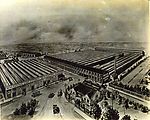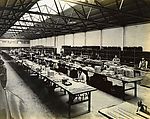 Bird's eye view of the Revo factory in Tipton in the 1920s
Bird's eye view of the Revo factory in Tipton in the 1920s Electrical element winding shop, Revo factory, Tipton, 1928
Electrical element winding shop, Revo factory, Tipton, 1928

As heavy industry declined in the 1920s and 1930s, new consumer industries were growing. Most of the new industries were located in the south-east of England and in the Midlands. They did little to help the plight of those in the north of England, Scotland and Wales, where unemployment was running at over 20%.
Despite the recession, those lucky enough to be in work were better off than before, and in a position to buy goods previously considered to be luxury items. With the introduction of electricity, factory owners were no longer dependent on steam power produced from coal, and could locate nearer to their domestic markets in the south-east and Midlands, a situation which further increased the prosperity of these regions. Ford, for example, built a new factory at Dagenham in Essex. Hoover was just one of the new factories located on the fringes of London. Lucas was a motor components firm based in Birmingham, and the Revo factory occupied a vast site in Tipton in the Black Country, producing all manner of electrical goods.
Assembly lines and conveyor belt production was typical of the new industries, especially in electrical engineering, synthetic fibres, food processing, car and materials production. They relied heavily on female workers. Many were young and single, but some had families to support and many of the new factories did not impose a marriage bar. These modern companies also paid higher rates than the women could get elsewhere.
Discipline in the new factories could be strict. At the Electric and Musical Industries’ (EMI) factory in Hayes, near London, work started at 7.33 a.m. Workers arriving late were locked out until lunch-time. The assembly line and conveyor belt proved to be useful tools in managing production, which could be speeded up at will. In one clothing factory employing mostly fifteen and sixteen year old girls, the system was so speeded up, and was so exhausting that the manager was forced to introduce a ten-minute rest period every hour. Organising assembly line workers in teams was also an effective way to discipline workers, because if anyone failed to keep up the pace, the whole group lost bonus.
Speed-up imposed by rate-fixers and time-study men was often resented, and even though the workers in the new industries had no trade union tradition, lightning, unofficial strikes were common. Perhaps one of the most significant was the strike at Lucas, in Birmingham. Jessie McCullough was one of the quickest workers on a line responsible for filing shock absorbers. She saw that she was being timed and realised that the line would be set at her speed, making it necessary for everyone to keep up the same pace. She turned to the Transport and General Workers’ Union for help. 10,000 women came out on strike. Within a week Lucas backed down. A few months later, however, Jessie and other activists were laid off and found it difficult to get work elsewhere in Birmingham.
It is clear that although the period between the wars saw the generation of a new form of power, a new generation of workers and a new generation of working practices, the struggle of working people for improved working conditions was set to continue.
Rollover the captions in the box to see the available images in thumbnail format, click the caption to see the full-size image
| Reference: | 756 |
| Keywords: | |
| Archive Ref: | |
| Updated: | Wed 9 Jul 2008 - 10 |
| Interpretation written by | Barbara Harris |
| Author's organisation | |
| Organisation's website |